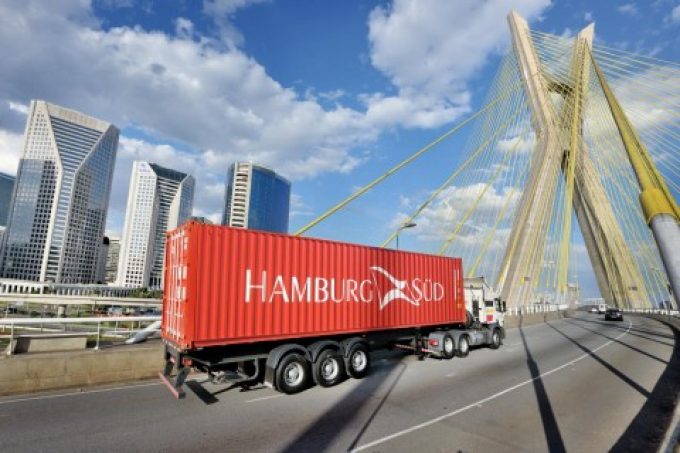Container spot rates have peaked as all major trades see prices fall
There was more evidence in this week’s container port freight markets that peak prices on ...
TFII: SOLID AS USUALMAERSK: WEAKENINGF: FALLING OFF A CLIFFAAPL: 'BOTTLENECK IN MAINLAND CHINA'AAPL: CHINA TRENDSDHL: GROWTH CAPEXR: ANOTHER SOLID DELIVERYMFT: HERE COMES THE FALLDSV: LOOK AT SCHENKER PERFORMANCEUPS: A WAVE OF DOWNGRADES DSV: BARGAIN BINKNX: EARNINGS OUTODFL: RISING AND FALLING AND THEN RISING
TFII: SOLID AS USUALMAERSK: WEAKENINGF: FALLING OFF A CLIFFAAPL: 'BOTTLENECK IN MAINLAND CHINA'AAPL: CHINA TRENDSDHL: GROWTH CAPEXR: ANOTHER SOLID DELIVERYMFT: HERE COMES THE FALLDSV: LOOK AT SCHENKER PERFORMANCEUPS: A WAVE OF DOWNGRADES DSV: BARGAIN BINKNX: EARNINGS OUTODFL: RISING AND FALLING AND THEN RISING

Relentless pressure on costs has forced shipping lines to embrace the wave of digitisation sweeping the ocean container freight industry.
Frank Smet, chief commercial officer at Hamburg Süd, told delegates at the keynote session of the TOC Americas Container Supply Chain conference in Cartagena yesterday that the only way to reverse the carrier industry’s eroding margins was to eliminate the additional costs it often needlessly incurred.
And the best way of achieving that was through digitisation, he added.
“We need to take out inefficiencies – and I don’t mean just squeezing the weakest link in the chain through procurement, because this doesn’t lead to acceptable returns either, and cannot be a long-term strategy,” he said.
Increased use of predictive analytics could improve vessel utilisation.
“The common estimate is that 10% of slots on the headhaul sailings remain unfilled. The top 10 carriers have around 16m teu capacity, so if we can reduce this to 5%, then, at a conservative figure of $10 per slot, you could see a combined saving of $5bn.
“The reason for the empty slots is that shipping lines have become lenient with no-shows, which are becoming more commonplace. During the peak season, no-shows can be up to 25% of a vessel’s bookings and, if all the carriers sailed with just 75% utilisation, they would go belly-up,” Mr Smet added.
The carriers’ standard response has been to overbook by 25-30%, which leads to cargo rollovers, which creates new cost for customers, he said.
“Every delay, every shunt of a box to another terminal brings extra cost. It affects the entire container supply chain, because no one lives up to their commitments, and carriers are reacting by rolling out new platforms where this commitment is reintroduced with penalties. I am convinced that this will improve utilisation.”
He said Hamburg Süd’s Instant online booking platform, formally launched in mid-September and developed in cooperation with parent Maersk, would guarantee no rollovers to shippers and forwarders booking through it.
He added that as shipping lines had exhausted most other avenues to profitability, they now needed to attack non-liner costs.
“An accelerated level of consolidation has certainly changed the landscape of the industry, but there has also been slower growth and reaching the end of the conversion process [of previously breakbulk or general cargo into containers].
“The deployment of ever-larger vessels, which has improved cost efficiency per slot, is coming to an end, and while these ships have created a lot of operational cost benefits at sea, they have created a lot of operational costs in ports and the hinterland.
“I could talk about the costs of empty repositioning; I could talk about the cost of container transport with merchant haulage; I could talk about the costs of hinterland congestion… there are so many inefficiencies we could address.”
And the way to address many of them is through digital solutions.
Projects such as the Maersk and IBM-sponsored Tradelens and carrier group the Digital Container Shipping Association (DCSA) are important developments, he said, because of their collaborative nature.
“I was very pleased that the DCSA was formed and that the major carriers can work together to create the standards because it’s been the greatest barriers to us so far,” he said.
Comment on this article
Gary Ferrulli
October 30, 2019 at 3:01 pmDigitization is a cost savor IF first there is a process review and refinement/improvement, then the technology required to support the more efficient process. But in relative terms, the costs associated with those processes where digitization can be used vs the operational costs associated with an ocean carriers are relatively minor. Example, when Sea-Land digitized in the mid-1990’s we saved about $21. Million a year on a $60. million investment. At the time we were a $5. Billion in total revenue and were making between $150. and $300. Million a year in operating income. The $21. Million was significant, but not what kept the company going. And it won’t save HMM, Yang Ming, Cosco etc, their respective governments have and will.